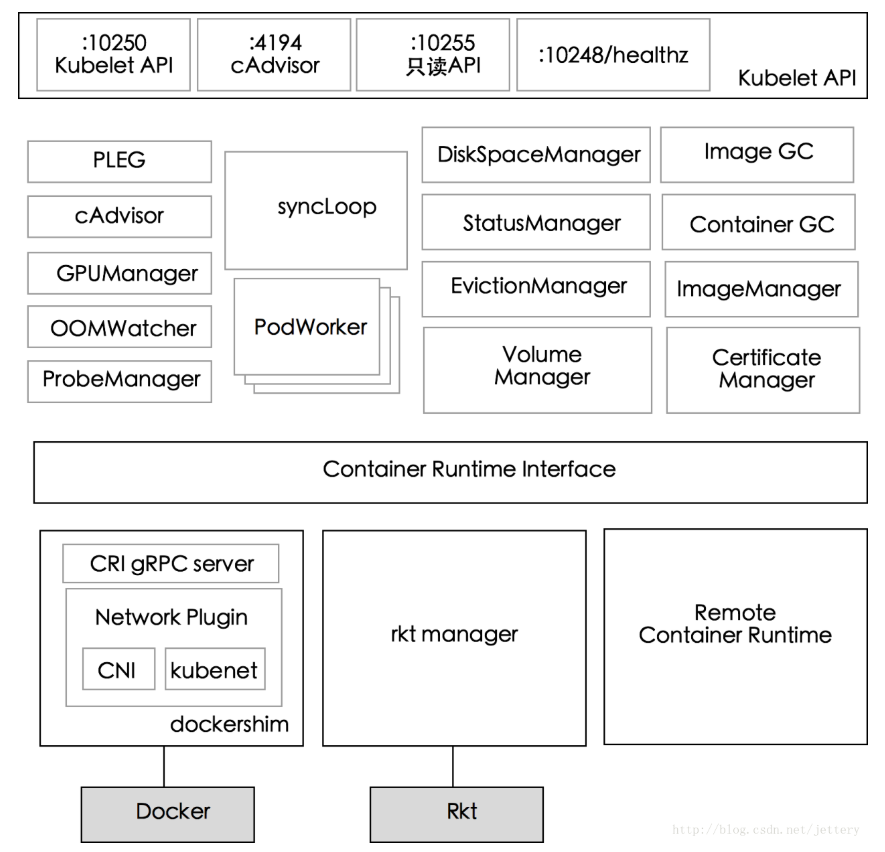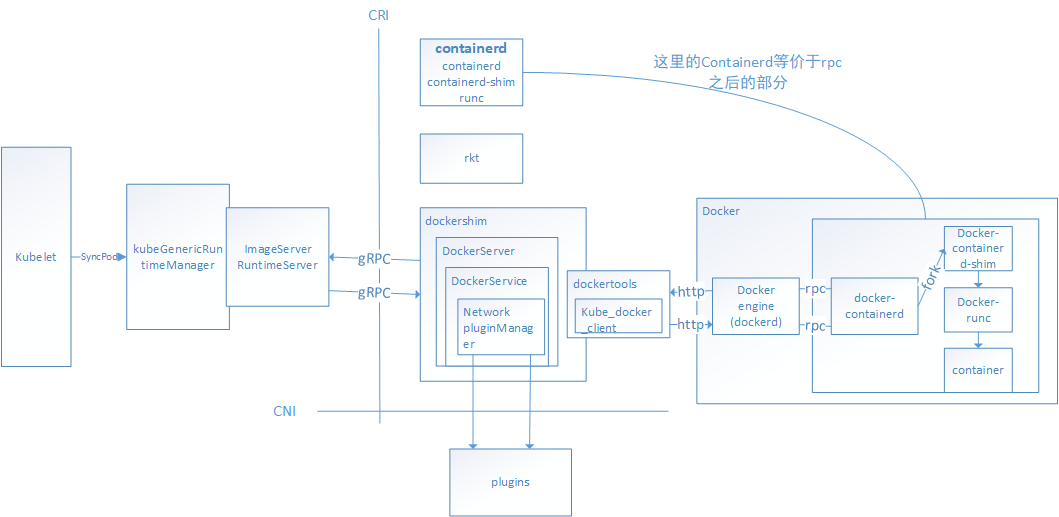1
2
3
4
5
6
7
8
9
10
11
12
13
14
15
16
17
18
19
20
21
22
23
24
25
26
27
28
29
30
31
32
33
34
35
36
37
38
39
40
41
42
43
44
45
46
47
48
49
50
51
52
53
54
55
56
57
58
59
60
61
62
63
64
65
66
67
68
69
70
71
72
73
74
75
76
77
78
79
80
81
82
83
84
85
86
87
88
89
90
91
92
93
94
95
96
97
98
99
100
101
102
103
104
105
106
107
108
109
110
111
|
// pkg/kubelet/dockershim/docker_sandbox.go
func (ds *dockerService) RunPodSandbox(ctx context.Context, r *runtimeapi.RunPodSandboxRequest) (*runtimeapi.RunPodSandboxResponse, error) {
config := r.GetConfig()
// Step 1: Pull the image for the sandbox.
...
if err := ensureSandboxImageExists(ds.client, image); err != nil {
return nil, err
}
// Step 2: Create the sandbox container.
if r.GetRuntimeHandler() != "" && r.GetRuntimeHandler() != runtimeName {
return nil, fmt.Errorf("RuntimeHandler %q not supported", r.GetRuntimeHandler())
}
createConfig, err := ds.makeSandboxDockerConfig(config, image)
if err != nil {
return nil, fmt.Errorf("failed to make sandbox docker config for pod %q: %v", config.Metadata.Name, err)
}
//创建sandbox
createResp, err := ds.client.CreateContainer(*createConfig)
if err != nil {
createResp, err = recoverFromCreationConflictIfNeeded(ds.client, *createConfig, err)
}
if err != nil || createResp == nil {
return nil, fmt.Errorf("failed to create a sandbox for pod %q: %v", config.Metadata.Name, err)
}
resp := &runtimeapi.RunPodSandboxResponse{PodSandboxId: createResp.ID}
ds.setNetworkReady(createResp.ID, false)
defer func(e *error) {
// Set networking ready depending on the error return of
// the parent function
if *e == nil {
ds.setNetworkReady(createResp.ID, true)
}
}(&err)
// Step 3: Create Sandbox Checkpoint.
if err = ds.checkpointManager.CreateCheckpoint(createResp.ID, constructPodSandboxCheckpoint(config)); err != nil {
return nil, err
}
// Step 4: Start the sandbox container.
// Assume kubelet's garbage collector would remove the sandbox later, if
// startContainer failed.
err = ds.client.StartContainer(createResp.ID)
if err != nil {
return nil, fmt.Errorf("failed to start sandbox container for pod %q: %v", config.Metadata.Name, err)
}
// Rewrite resolv.conf file generated by docker.
// NOTE: cluster dns settings aren't passed anymore to docker api in all cases,
// not only for pods with host network: the resolver conf will be overwritten
// after sandbox creation to override docker's behaviour. This resolv.conf
// file is shared by all containers of the same pod, and needs to be modified
// only once per pod.
if dnsConfig := config.GetDnsConfig(); dnsConfig != nil {
containerInfo, err := ds.client.InspectContainer(createResp.ID)
if err != nil {
return nil, fmt.Errorf("failed to inspect sandbox container for pod %q: %v", config.Metadata.Name, err)
}
if err := rewriteResolvFile(containerInfo.ResolvConfPath, dnsConfig.Servers, dnsConfig.Searches, dnsConfig.Options); err != nil {
return nil, fmt.Errorf("rewrite resolv.conf failed for pod %q: %v", config.Metadata.Name, err)
}
}
// Do not invoke network plugins if in hostNetwork mode.
if config.GetLinux().GetSecurityContext().GetNamespaceOptions().GetNetwork() == runtimeapi.NamespaceMode_NODE {
return resp, nil
}
// Step 5: Setup networking for the sandbox.
// All pod networking is setup by a CNI plugin discovered at startup time.
// This plugin assigns the pod ip, sets up routes inside the sandbox,
// creates interfaces etc. In theory, its jurisdiction ends with pod
// sandbox networking, but it might insert iptables rules or open ports
// on the host as well, to satisfy parts of the pod spec that aren't
// recognized by the CNI standard yet.
cID := kubecontainer.BuildContainerID(runtimeName, createResp.ID)
networkOptions := make(map[string]string)
if dnsConfig := config.GetDnsConfig(); dnsConfig != nil {
// Build DNS options.
dnsOption, err := json.Marshal(dnsConfig)
if err != nil {
return nil, fmt.Errorf("failed to marshal dns config for pod %q: %v", config.Metadata.Name, err)
}
networkOptions["dns"] = string(dnsOption)
}
err = ds.network.SetUpPod(config.GetMetadata().Namespace, config.GetMetadata().Name, cID, config.Annotations, networkOptions)
if err != nil {
errList := []error{fmt.Errorf("failed to set up sandbox container %q network for pod %q: %v", createResp.ID, config.Metadata.Name, err)}
// Ensure network resources are cleaned up even if the plugin
// succeeded but an error happened between that success and here.
err = ds.network.TearDownPod(config.GetMetadata().Namespace, config.GetMetadata().Name, cID)
if err != nil {
errList = append(errList, fmt.Errorf("failed to clean up sandbox container %q network for pod %q: %v", createResp.ID, config.Metadata.Name, err))
}
err = ds.client.StopContainer(createResp.ID, defaultSandboxGracePeriod)
if err != nil {
errList = append(errList, fmt.Errorf("failed to stop sandbox container %q for pod %q: %v", createResp.ID, config.Metadata.Name, err))
}
return resp, utilerrors.NewAggregate(errList)
}
return resp, nil
}
|

